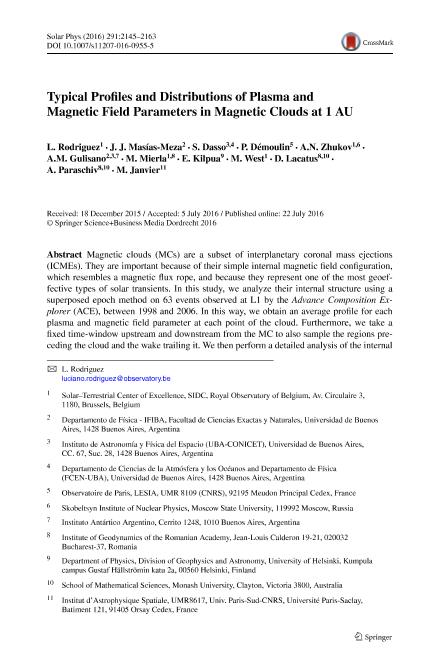Mostrar el registro sencillo del ítem
dc.contributor.author
Rodriguez, L.
dc.contributor.author
Masías Meza, Jimmy Joel

dc.contributor.author
Dasso, Sergio Ricardo

dc.contributor.author
Démoulin, Pascal

dc.contributor.author
Zhukov, A. N.
dc.contributor.author
Gulisano, Adriana Maria

dc.contributor.author
Mierla, M.
dc.contributor.author
Kilpua, E.
dc.contributor.author
West, M.
dc.contributor.author
Lacatus, D.
dc.contributor.author
Paraschiv, A.
dc.contributor.author
Janvier, M.
dc.date.available
2019-10-11T15:06:00Z
dc.date.issued
2016-07
dc.identifier.citation
Rodriguez, L.; Masías Meza, Jimmy Joel; Dasso, Sergio Ricardo; Démoulin, Pascal; Zhukov, A. N.; et al.; Typical Profiles and Distributions of Plasma and Magnetic Field Parameters in Magnetic Clouds at 1 AU; Springer; Solar Physics; 291; 7; 7-2016; 2145-2163
dc.identifier.issn
0038-0938
dc.identifier.uri
http://hdl.handle.net/11336/85698
dc.description.abstract
Magnetic clouds (MCs) are a subset of interplanetary coronal mass ejections (ICMEs). They are important because of their simple internal magnetic field configuration, which resembles a magnetic flux rope, and because they represent one of the most geoeffective types of solar transients. In this study, we analyze their internal structure using a superposed epoch method on 63 events observed at L1 by the Advance Composition Explorer (ACE), between 1998 and 2006. In this way, we obtain an average profile for each plasma and magnetic field parameter at each point of the cloud. Furthermore, we take a fixed time-window upstream and downstream from the MC to also sample the regions preceding the cloud and the wake trailing it. We then perform a detailed analysis of the internal characteristics of the clouds and their surrounding solar wind environments. We find that the parameters studied are compatible with log-normal distribution functions. The plasma β and the level of fluctuations in the magnetic field vector are the best parameters to define the boundaries of MCs. We find that one third of the events shows a peak in plasma density close to the trailing edge of the flux ropes. We provide several possible explanations for this result and investigate if the density peak is of a solar origin (e.g. erupting prominence material) or formed during the magnetic cloud travel from the Sun to 1 AU. The most plausible explanation is the compression due to a fast overtaking flow, coming from a coronal hole located to the east of the solar source region of the magnetic cloud.
dc.format
application/pdf
dc.language.iso
eng
dc.publisher
Springer

dc.rights
info:eu-repo/semantics/openAccess
dc.rights.uri
https://creativecommons.org/licenses/by-nc-sa/2.5/ar/
dc.subject
CORONAL MASS EJECTIONS, LOW CORONAL SIGNATURES, INITIATION AND PROPAGATION
dc.subject
INTERPLANETARY CORONAL MASS EJECTIONS
dc.subject
MAGNETIC CLOUDS
dc.subject
SPACE WEATHER
dc.subject.classification
Astronomía

dc.subject.classification
Ciencias Físicas

dc.subject.classification
CIENCIAS NATURALES Y EXACTAS

dc.title
Typical Profiles and Distributions of Plasma and Magnetic Field Parameters in Magnetic Clouds at 1 AU
dc.type
info:eu-repo/semantics/article
dc.type
info:ar-repo/semantics/artículo
dc.type
info:eu-repo/semantics/publishedVersion
dc.date.updated
2019-10-04T18:37:55Z
dc.journal.volume
291
dc.journal.number
7
dc.journal.pagination
2145-2163
dc.journal.pais
Alemania

dc.journal.ciudad
Berlin
dc.description.fil
Fil: Rodriguez, L.. Royal Observatory Of Belgium; ; Bélgica
dc.description.fil
Fil: Masías Meza, Jimmy Joel. Consejo Nacional de Investigaciones Científicas y Técnicas. Oficina de Coordinación Administrativa Ciudad Universitaria. Instituto de Física de Buenos Aires. Universidad de Buenos Aires. Facultad de Ciencias Exactas y Naturales. Instituto de Física de Buenos Aires; Argentina
dc.description.fil
Fil: Dasso, Sergio Ricardo. Consejo Nacional de Investigaciónes Científicas y Técnicas. Oficina de Coordinación Administrativa Ciudad Universitaria. Instituto de Astronomía y Física del Espacio. - Universidad de Buenos Aires. Facultad de Ciencias Exactas y Naturales. Instituto de Astronomía y Física del Espacio; Argentina
dc.description.fil
Fil: Démoulin, Pascal. Centre National de la Recherche Scientifique. Observatoire de Paris; Francia
dc.description.fil
Fil: Zhukov, A. N.. Royal Observatory Of Belgium; Bélgica
dc.description.fil
Fil: Gulisano, Adriana Maria. Ministerio de Relaciones Exteriores, Comercio Interno y Culto. Dirección Nacional del Antártico. Instituto Antártico Argentino; Argentina
dc.description.fil
Fil: Mierla, M.. Royal Observatory Of Belgium; Bélgica
dc.description.fil
Fil: Kilpua, E.. Helsingin Yliopisto; ; Finlandia
dc.description.fil
Fil: West, M.. Royal Observatory Of Belgium; ; Bélgica
dc.description.fil
Fil: Lacatus, D.. Monash University; Australia
dc.description.fil
Fil: Paraschiv, A.. Monash University; Australia
dc.description.fil
Fil: Janvier, M.. Universite Paris-sud Xi;; Francia
dc.journal.title
Solar Physics

dc.relation.alternativeid
info:eu-repo/semantics/altIdentifier/doi/http://dx.doi.org/10.1007/s11207-016-0955-5
Archivos asociados
